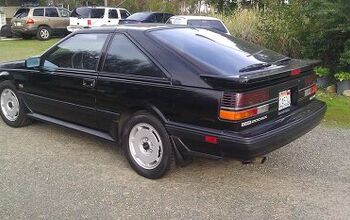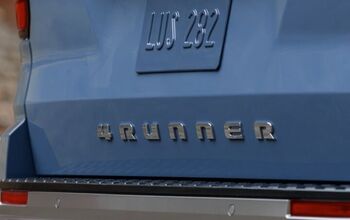Why Toyota And Ford Hooked Up: It's The CAFE Credits, Stupid
Today’s announcement of a memorandum of understanding between Ford and Toyota, uniting the two firms’ pickup truck hybrid drivetrain efforts, took quite a few industry-watchers by surprise this morning. As the industry leader in hybrid technology, Toyota has limited past hybrid cooperation to licensing its drivetrain wholesale to Nissan and a patent-sharing agreement with Ford. Moreover, the last big alliance aimed at developing hybrid technology for full-sized pickups, the Two-Mode V8 hybrids developed jointly by GM, Chrysler, Mercedes and BMW, have been a huge flop on the market, with the German partners walking away from the technology after using it in only a single application each (X5/X6, and ML Hybrid). Though Toyota and Ford have worked together to prevent a messy patent war over hybrid technology, there was little to suggest that they would take the cooperation any further, let alone join forces to hybridize full-size pickups. But if you’re looking to the marketplace to explain the Ford-Toyota tie-up, you’re looking in the wrong place: this is all about the freshly-announced CAFE standard and its generous credit system.
Of course, that’s not how the move is being pitched… at least on the surface. But in his announcement of the deal, Toyota Executive VP Takeshi Uchiyamada makes it clear that the hybrid and telematics alliance is entirely focused on the US market, saying:
Our collaboration with Ford is a move to make hybrid technology more widely available in sport-utility vehicles and in trucks. Those kinds of models are indispensable to American customers. And providing them with our hybrid technology will help conserve energy and reduce output of greenhouse gas here in the United States. That was our thinking in considering the collaboration.
How does Uchiyamada-san know how “indispensable” full-sized pickups are to Americans? The issue of full-sized trucks has dominated the debate over 2017-2025 CAFE standards, with the industry and its allies intervening to lower truck standards and increase the credit loopholes that make it easier to keep pickups relatively thirsty. This had two effects: first, the lowering of truck standards confirmed that large pickups would be worth investing in over the long term, and second, one loophole in specific provides huge incentives to hybridize full-sized trucks.
I covered the rough outlines of this credit loophole in my write up of the proposed rule, but to refresh your memory, here’s what the rule itself [ PDF] says about its hybrid pickup credit
The agencies intend to solicit information on technologies that offer significant increases in fuel efficiency and reduction in greenhouse gas emissions. We intend to propose a credit for manufacturers that employ significant quantities of hybridization on full size pickup trucks, by including a per-vehicle credit available for mild and strong hybrid electric vehicles (HEVs). This provides the opportunity to begin to transform the most challenging category of vehicles in terms of the penetration of advanced technologies, allowing additional opportunities to successfully achieve the higher levels of truck stringencies in MY 2022-2025.
In other words, not only did the government reduce the required rate of efficiency improvement for trucks to nearly half what it is for cars, they also went a step further by giving credits for specific (i.e. hybrid) technology. Absent these credits, it’s highly likely that truck-dependent manufacturers would have looked to diesel power as a way to cheaply provide high-torque, high-efficiency truck powerplants, but with the feds placing their finger on the scale in favor of hybrids, Ford has no choice but to invest in the technology. And as the only Detroit-based (and therefore heavily truck-dependent) automaker to not have access to the Two-Mode technology, Ford had to move fast to find a partner. Though Chrysler and GM’s Two-Modes may not have been successful so far, they at least provide the building blocks for future development.
Besides, as we read more about the hybrid pickup credits, it’s clear that even if the 2017+ hybrid pickups aren’t super-efficient, the credits make them incredibly valuable.
The agencies intend that access to this credit is conditioned on a minimum penetration of the technology in a manufacturer’s full size pickup truck fleet, with defined criteria for a full size pickup truck (e.g., minimum bed size and minimum towing capability). The agencies intend to propose that mild HEV pickup trucks are eligible for a 10 g/mi12 credit during 2017-2021 if the technology is used on a minimum percentage of a company’s full size pickups, beginning with at least 30% of a company’s full size pickup production in 2017 and ramping up to at least 80% in 2021. Strong HEV pickup trucks would be eligible for a 20g/mi credit during 2017-2025 if the technology is used on at least 10% of the company’s full size pickups.
The agencies will propose specific definitions of mild and strong HEV pickup trucks, but expect to include stop/start, regenerative braking, minimum motor power, minimum battery voltage value and minimum energy storage capacity, or similar types of objective metrics. The agencies expect that a “mild” HEV will include moderate hybridization and not just start/stop, and that a “strong” HEV will include launch assist.
Let’s assume for the moment that the Ford-Toyota pickup drivetrain, which each company will integrate into future vehicles independently of one another, meets the government’s requirement for “strong” hybrids. If you look at the changes in maximum truck C02 targets from 2017-2025, they increase by the following amounts:
2017-2018: 5.5g/mile
2018-2019: 3.1g/mile
2019-2020: 1.9g/mile
2020-2021: 1.9g/mile
2021-2022: 14g/mile
2022-2023: 15.2g/mile
2023-2024: 14.6g/mile
2024-2025: 13.9g/mile
But under this credit system, if ten percent or more of your truck fleet have “strong hybrid” drivetrains, each truck earns a 20g/mile credit which can be applied to under-complying vehicles, “banked” for future under-compliance or “carried-back” for past under-compliance. In theory, this also means that a 2017 model-year pickup that exactly met the maximum CO2 target for that year would add 14.5g/mile to the automaker’s fleetwide efficiency rating in 2018, without improving its efficiency at all. In 2019, it would add 11.4g/mile in credits without improving efficiency, by 2020 the credit would shrink to 9.5 and in 2021 it would still be adding 7.6g/mile in credits despite not improving since 2017. If, for example, Ford had decided it could meet CAFE in that window with diesel technology alone, it would only receive additional credits if it “significantly” overcomplied with the standard, year-by-year. To wit:
The agencies also intend to propose a performance based incentive credit for full size pickup trucks which achieve a significant reduction below the applicable target. This credit could also be on the order of 10-20 gm/mile vehicle. The same vehicle would not receive credit under both the HEV and the performance based approaches.
Without a hybrid pickup drivetrain to build off of the way GM and Chrysler do, Ford has two choices for its truck strategy in 2017 and beyond: either keep costs as low as possible and hope it can undercomply with improved gas and diesel engines and improved aerodynamic efficiency and/or weight loss, or find a partner for hybrid technology and receive significant credits tied only to its use of hybrid technology rather than its actual efficiency. If that’s not a no-brainer, I don’t know what is.
But what does Toyota get out of the deal? Though it’s the clear leader in hybrid technology, its drivetrains have all been been based on transverse engines and front-wheel drive. Toyota’s expertise in full-sized, American-market trucks pales in comparison to Fords, and at this point it could even be said that Ford has the head-start on hybrid pickups, having begun joint development (with CCEFP and Folsom Technologies) on a hydraulic hybrid F-150. Autopacific analyst Dave Sullivan has another take, writing at vehiclevoice.com that
Based on the press conference today, it pretty much sounds like Toyota has a RWD hybrid system in development but they need Ford’s sales volume to make it work from a cost perspective.
Whether Toyota or Ford started development first almost doesn’t matter (the press release says “both companies have been working independently on their own future-generation rear-wheel drive hybrid systems”). For Ford, a hybrid pickup drivetrain is must-have technology, due to the CAFE loopholes. For Toyota, which is less dependent on full-sizers, the need isn’t quite as dire (as CAFE offers plenty of credit opportunities for plug-in cars), but Sullivan is absolutely right that having Ford as a partner will lower costs dramatically. All in all, the deal seems to be a win-win… if only because of the way future CAFE standards were written.
More by Edward Niedermeyer
Latest Car Reviews
Read moreLatest Product Reviews
Read moreRecent Comments
- Theflyersfan I used to love the 7-series. One of those aspirational luxury cars. And then I parked right next to one of the new ones just over the weekend. And that love went away. Honestly, if this is what the Chinese market thinks is luxury, let them have it. Because, and I'll be reserved here, this is one butt-ugly, mutha f'n, unholy trainwreck of a design. There has to be an excellent car under all of the grotesque and overdone bodywork. What were they thinking? Luxury is a feeling. It's the soft leather seats. It's the solid door thunk. It's groundbreaking engineering (that hopefully holds up.) It's a presence that oozes "I have arrived," not screaming "LOOK AT ME EVERYONE!!!" The latter is the yahoo who just won $1,000,000 off of a scratch-off and blows it on extra chrome and a dozen light bars on a new F150. It isn't six feet of screens, a dozen suspension settings that don't feel right, and no steering feel. It also isn't a design that is going to be so dated looking in five years that no one is going to want to touch it. Didn't BMW learn anything from the Bangle-butt backlash of 2002?
- Theflyersfan Honda, Toyota, Nissan, Hyundai, and Kia still don't seem to have a problem moving sedans off of the lot. I also see more than a few new 3-series, C-classes and A4s as well showing the Germans can sell the expensive ones. Sales might be down compared to 10-15 years ago, but hundreds of thousands of sales in the US alone isn't anything to sneeze at. What we've had is the thinning of the herd. The crap sedans have exited stage left. And GM has let the Malibu sit and rot on the vine for so long that this was bound to happen. And it bears repeating - auto trends go in cycles. Many times the cars purchased by the next generation aren't the ones their parents and grandparents bought. Who's to say that in 10 years, CUVs are going to be seen at that generation's minivans and no one wants to touch them? The Japanese and Koreans will welcome those buyers back to their full lineups while GM, Ford, and whatever remains of what was Chrysler/Dodge will be back in front of Congress pleading poverty.
- Corey Lewis It's not competitive against others in the class, as my review discussed. https://www.thetruthaboutcars.com/cars/chevrolet/rental-review-the-2023-chevrolet-malibu-last-domestic-midsize-standing-44502760
- Turbo Is Black Magic My wife had one of these back in 06, did a ton of work to it… supercharger, full exhaust, full suspension.. it was a blast to drive even though it was still hilariously slow. Great for drive in nights, open the hatch fold the seats flat and just relax.Also this thing is a great example of how far we have come in crash safety even since just 2005… go look at these old crash tests now and I cringe at what a modern electric tank would do to this thing.
- MaintenanceCosts Whenever the topic of the xB comes up…Me: "The style is fun. The combination of the box shape and the aggressive detailing is very JDM."Wife: "Those are ghetto."Me: "They're smaller than a Corolla outside and have the space of a RAV4 inside."Wife: "Those are ghetto."Me: "They're kind of fun to drive with a stick."Wife: "Those are ghetto."It's one of a few cars (including its fellow box, the Ford Flex) on which we will just never see eye to eye.

































Comments
Join the conversation
Sounds like Toyota throwing in the towel on the U.S. truck market to me. I think they've finally realized that they will never beat Detroit in the full-size market under normal conditions, so now they have to find a back door in; associating with Ford is how they will accomplish this. I think Toyota might swing to have a rebadged F-Series sold through Toyota dealerships with this new technology, but I highly doubt Ford would ever agree to that. With Toyota's share declining in the bread-and-butter compact and sedan markets, I see this as kind of a desperation play to open up new avenues for revenue. When the 2013 Camry doesn't reverse the trend, it will be even more obvious.
CAFE turned out to be a huge problem...it put all of us into "trucks" when what we really need is station wagons.